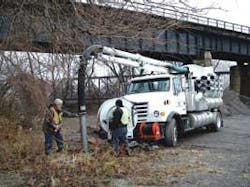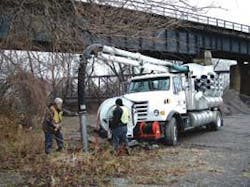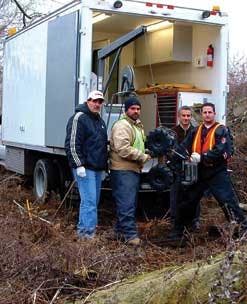Collection System Crew's "Can Do" Attitude Helps City Comply with Environmental Mandates
By Suzan Marie Chin
In March 2002 the City of Youngstown, OH, announced an agreement with the Federal and Ohio EPA Authorities to develop a long-term sewage discharge control plan that would result in significant benefit to the environment. The agreement created a schedule for the city to follow in order to eliminate direct discharges of sewage and sewer overflow near the area known as Mill Creek Park, replace two pump stations and make significant improvement to operation and maintenance of the sewer system.
The first project scheduled under the plan was the cleaning and inspection of 11 sections of a 60" diameter sewer interceptor. The project scope was larger than anything the Youngstown staff had ever encountered and a decision to contract out or keep it in house needed to be made.
It appeared that the easy solution was to contract the project out. Lou Zorella, Catch Basin Supervisor for the City of Youngstown, had a differing opinion. Zorella approached Lawrence Gurlea, Superintendent for Wastewater Plants for Youngstown, with the idea that the city's crew could complete the project with the addition of some new equipment and support.
Gurlea was cautious, "I knew we had a timetable to meet and it was crunchtime. There would be fines assessed if we didn't meet our deadline. Plus, it would require us to set aside other projects." He was, however, willing to investigate the possibilities.
In order for the city crew to complete the project several pieces of new equipment would be needed. The city had taken delivery of a new Vactor 2110 about 12 months prior and Zorella was concerned that due to the length and demands of the interceptor project, this new unit would potentially burn out. With Gurlea's help, approval was granted by the city's Engineering Department to purchase another unit if the existing Vactor truck burned out as a result of the project. In addition, because of the money saved (approximately $500,000) by bringing the work in house vs. contract, they were also given the approval to purchase a new CCTV inspection vehicle.
After additional discussion and assessment by the department, Zorella and his crew were given the green light to bring the project in-house.
Zorella and Gurlea called upon Karl Dickinson of Jack Doheny Supplies of Twinsburg, OH, to assist them with the assessment and procurement of the additional equipment needed for the project. Doheny Supplies is part of the State of Ohio Cooperative Bidding Program, which streamlined purchasing for Youngstown.
They acquired a snorkel kit for more efficient underwater cleaning and a bulldozer nozzle by ENZ USA. After the first interceptor project was completed, they took delivery of two bucket machines by Sewer Equipment Co. of America and a Pearpoint CCTV inspection vehicle equipped with a mainline inspection system including dual tractors and flexidata™ pipe survey reporting software.
Training was a critical factor to the success of Zorella's crew.
"They attacked the project with a can-do attitude and that they were going to succeed and do a better job than anybody else could do with their sewers," Dickinson said. "Equipment was important, but even more critical was the training and support. They took full advantage of all the training and specialized services available from Doheny."
The Doheny staff worked closely with Youngstown to help the crew learn how to more efficiently clean pipe, conduct TV inspections and get top performance from all of their equipment.
Case in point, at the beginning of the interceptor cleaning project, a crew of three men was required when using the Vactor truck. This was of concern to Gurlea, as one of the crewmembers was there just to turn a fire hydrant off and on for the water supply to the truck. The crew was using fire hose because at the typical volume of 80 gpm, the tank supply would be used up very quickly – approximately every 15 minutes.
The tank couldn't be pressurized, since any overflows onto the ground in cold weather could become a hazard. A better solution to controlling the water flow was needed.
Zorella called Dan Coley, General Manager of Doheny Supplies, and asked him if there was a way to get the job done, keep the water flowing but do it with a crew of only two. Coley went to the job site and came up with a simple, cost effective solution —- an on/off switch could be added to truck. The switch would work on a float so that when the tank was full, it would trigger a valve that would leave the fire hose pressurized but not the tank, thereby alleviating the need for the third crewmember for water control.
The Project
The Mill Creek interceptor sections were at least 60 years old and had never been cleaned or inspected to Gurlea's knowledge. They were deep offroad and temporary roads had to be cut to give access for the equipment. The project commenced in October 2001 with a completion due date of June 30, 2002. It was determined that the crew would need to spend 40 hours per week on the project and that it would take a full six months but would not require overtime.
The sections run parallel along the river and lie between two sets of siphons. One set goes under Mill Creek and the other under the Mahoning River. The siphons are comprised of twin 20" barrels. The set going under the Mahoning (downstream) was partially obstructed, allowing large amounts of sediment to back up into the interceptor line —- all the way to the upstream siphon set.
Maximum production was vital to meet the target date and the project required a great deal of patience.
"Some days, I'd get a call from the crew that they had only completed 30 feet but got a truckload (9-yard box) out of that small area," Zorella said.
To keep production levels at maximum, Doheny outfitted the Vactor with an underwater vacuum air induction system that allowed the crew to pull heavier volumes of material underwater more efficiently. When the truck could not be used, such as with deep underwater situations, bucket machines were put into production.
During the course of work, the crew had to replace several jet and vacuum hoses, which was anticipated. The debris collection process had a sand blasting effect on the hose. They procured a few extra hoses but before putting them into service, sent them to Michigan to be hard coated, which increased the hoses' life.
At the project's on-time conclusion, the team had completed the 11 required sections, for a total of 2600 feet and extracted 575 tons of material.
"This project couldn't have happened without the dedication of everyone involved, we had a lot of help from our vendor and our employees, who weren't afraid to experiment and try new things," Gurlea said.
Value Added Bonuses
The equipment additions will certainly be earning their keep as Youngstown moves forward with its aggressive maintenance program to eliminate overflows. By taking a proactive approach, the Millcreek interceptor and other areas of the system will now be easier to maintain.
As with the interceptor project, the bulk of the collection systems work done by the city is offroad so its new Pearpoint inspection system was outfitted in a 4x4 offroad capable vehicle. With the addition of this vehicle, the city can develop a routine TV inspection program of its entire system and keep the work in-house.
Prior to the new Pearpoint system, which is tractor-based with a full pan & tilt camera, the city had a camera that they pulled with a winch system.
"The new system requires less crew and setup equipment, you just send two guys out and at the end of the day they can bring you back the reports you need," Zorella said.
The city also has "gone digital" for the collection of their TV inspection survey data. Out in the field, and back in the office, Youngstown is using flexidata™ pipe survey reporting software with its CCTV system. The software provides printed reports along with a digital video survey on DVD/CD with digital links to defect observations.
"Going this route is very helpful. I can bring the reports to my supervisor and show him instantly on the CD where the problems are and what we need to address. Plus, now instead of having to dig through piles of tapes and find the source of a problem, I can call our assistant pre-treatment coordinator in the office from out in the field and he can bring up the information in flexidata within minutes and let me know what my crew is dealing with," Zorella said.
In addition, the reports generated by flexidata will be beneficial for Youngstown when dealing with EPA, as they will provide an on-going written record of the program's progress and compliance with the mandate agreement.
The city is also using the camera system on root sawing projects. By following the root cutter with the camera, the crew is able to verify that the roots have been removed sufficiently and if something has been missed, a quick radio call to the operator can pinpoint uncut areas that can then be addressed.
Currently, the crew is working on another major cleaning and inspection project in the Sugar Creek area that is similar, but much smaller than the Mill Creek interceptor project.



